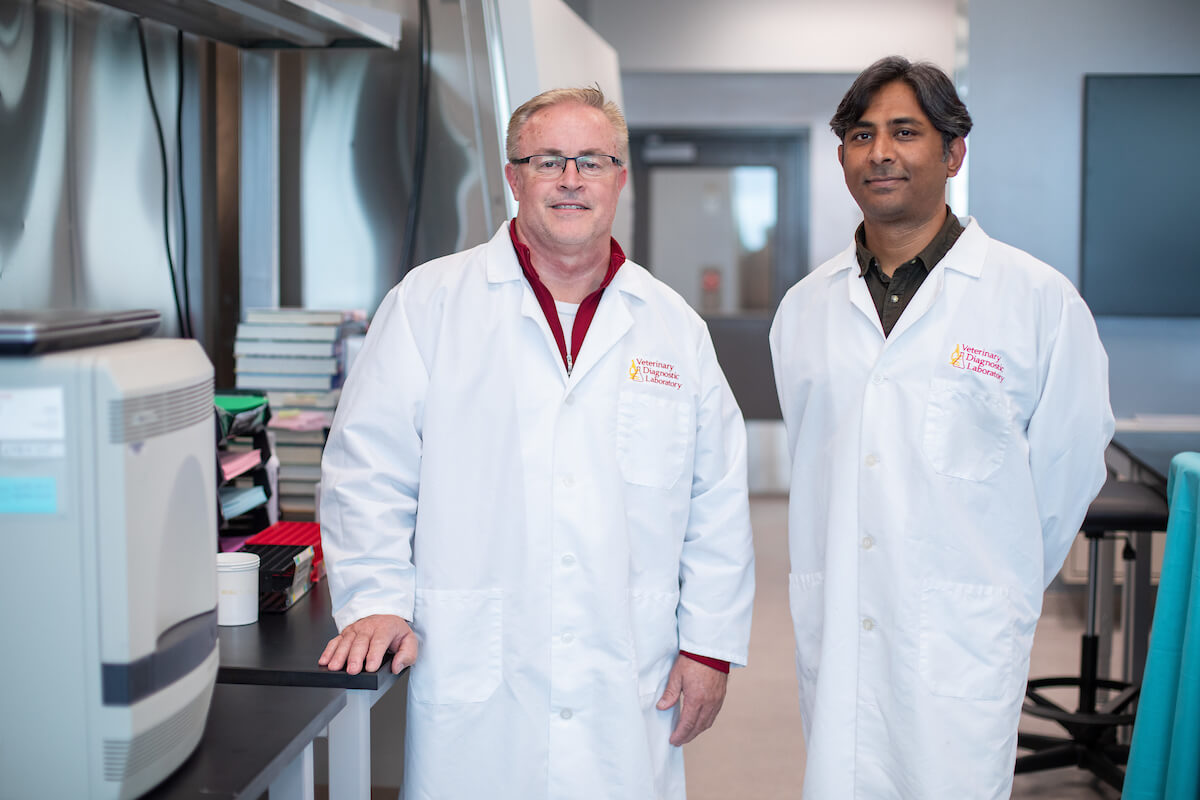‘We Want to be Prepared’: ISU Develops Test for Japanese Encephalitis Virus
Dave Roepke, Iowa State University News Service
Posted Jun 4, 2024

Dave Roepke, Iowa State University News Service
Posted Jun 4, 2024

Phillip Gauger, left, and Rahul Nelli in a laboratory in the Veterinary Diagnostic Laboratory. Photo by Christopher Gannon/Iowa State University.
When porcine epidemic diarrhea virus struck U.S. pig herds in 2013, the Iowa State University Veterinary Diagnostic Laboratory – which carries the nation’s largest swine caseload – scrambled to design a high-capacity test to keep up with the outbreak.
The experience of responding to PEDV had a lasting impact, said Dr. Phillip Gauger, who leads the VDL’s molecular testing unit. It’s part of the reason VDL researchers have developed a diagnostic test for swine to detect Japanese encephalitis virus, a mosquito-borne disease common in southeast Asia that hasn’t been seen in the U.S.
“With PEDV, we had to play a little catch-up to manage the large caseload. That’s not to say that will happen with JEV, but because of our experience with PEDV and knowing the U.S. swine industry is always at risk for emerging or transboundary viruses, we want to be prepared,” said Gauger, a professor of veterinary diagnostic and production animal medicine.
JEV became a higher priority after it spread to Australia in 2022, prompting the Swine Health Information Center – a pork checkoff-funded industry organization charged with monitoring swine diseases – to fund development of a real-time polymerase chain reaction test for JEV, the same genetically based screening method considered the gold standard for diagnosing COVID-19.
The project at the ISU VDL was headed up by Rahul Nelli, a research assistant professor of veterinary diagnostic and production animal medicine. Building a PCR diagnostic test begins by analyzing the pathogen’s genetic sequence, looking for distinct sections to target with small segments of DNA called primers. The primers carry a fluorescent dye and are designed to attach only to the unique portions of genetic code found in the pathogen. As samples are heated, cooled and treated with an enzyme to promote duplication, many DNA strands that include the fluorescent primers are created. If testing machines detect glowing, the sample is positive.
Nelli said the test he developed for JEV took some cues from an earlier design used during the Australian outbreak, but adjustments were needed because primers used in that test also detected West Nile Virus – a closely related virus also spread by mosquitoes.
Obtaining known samples of JEV to assess the new PCR test was difficult, given it hasn’t been detected in the U.S. Nelli secured inactivated JEV samples from the World Reference Center for Emerging Viruses and Arboviruses in Galveston, Texas.
“You can’t just get those just anywhere. These samples are very controlled,” he said.
The VDL test will be further validated on known samples in Australia to confirm its accuracy, which could take about a year, Nelli said. To be used in regulatory testing, it must be approved by the U.S. Department of Agriculture’s Foreign Animal Disease Diagnostic Laboratory.
Having a federally approved JEV test ready would help mitigate the damage of a possible outbreak, which could cause a drop in U.S. pork production of 1-2% and lead to economic losses of up to $612 million, according to an estimate commissioned by the Swine Health Information Center. While most cases of JEV in pigs lead to minor symptoms, it can cause neurological and reproductive issues.
JEV also poses risks for other animals, including humans. Severe symptoms in infected humans are rare, but in the 1 in 250 cases where they develop, the fatality rate is as high as 30%, according to the World Health Organization. The test developed at Iowa State, which can detect all five genotypes of JEV, could be used for humans, Nelli said.
The project shows the important role the VDL plays in animal and human health, Nelli said. The lab’s resources – and its unmatched food animal caseload – give it a unique advantage in building new diagnostic tools.
“These tests are hard for other labs to develop because they don’t have the sheer sample volume of the ISU VDL. We have so much volume that when we’re doing this testing, you get the statistical power of thousands of samples a day,” he said.
